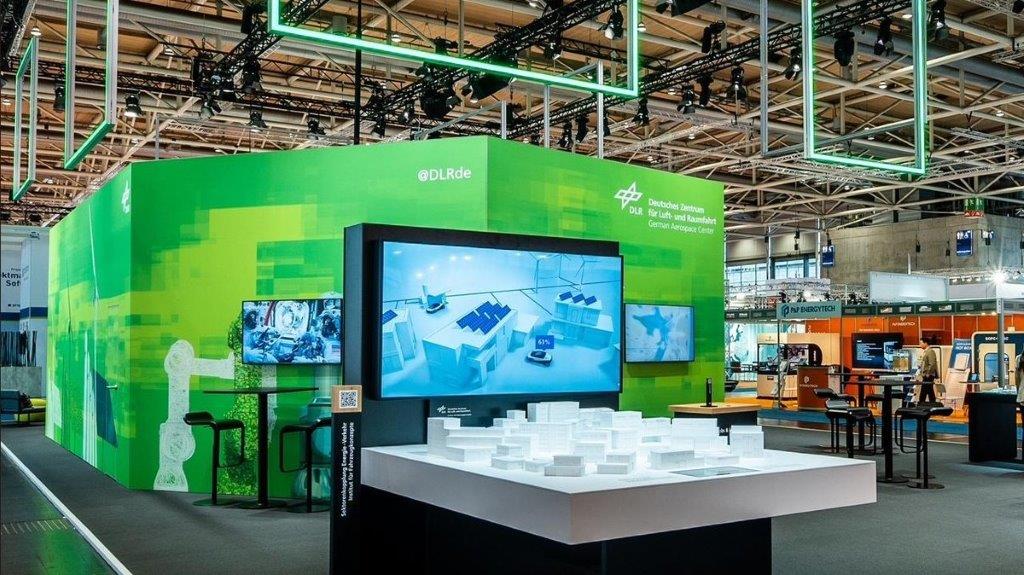German Aerospace Center Presented Future Fuels and Industrial Production Techniques at Hannover Messe 2023

The German Aerospace Center (Deutsches Zentrum für Luft- und Raumfahrt; DLR) showcased a range of technologies, innovations, and successful technology transfer and spin-off projects at Hannover Messe. The DLR stand provided an insight into how DLR is supporting industrial success with its research projects and working together with companies to shape the future of the industrial, energy, and mobility sectors.
“The application of knowledge, technology, and research findings to concrete needs in industry and society enables us to address major challenges in difficult times. DLR demonstrated the underlying processes at Hannover Messe 2023. Whether it’s know-how for the energy and mobility transition, the latest production technologies for the factory of the future, or dynamic start-ups transferring expertise from DLR to the market—research, transfer, and application go hand in hand for the benefit of industry and society,” says Karsten Lemmer, Member - DLR Executive Board, Innovation, Transfer and Scientific Infrastructure.
Solar Fuels—DLR technologies for industrial production
One thematic highlight at Hannover Messe was the development of technical components and processes for the production of solar fuels. These components close the technological gap between fundamental research, transfer, and industrial application in the field of alternative, climate-compatible fuels.
Solar fuels can be produced in a carbon-neutral manner from solar energy, water, and carbon. DLR is researching the solar technologies that are used to convert them into electricity and other fuels. An interactive exhibit will demonstrate to visitors how this works: heliostat fields capture sunlight and concentrate it on a central point high up in a solar tower. In the tower is a special reactor developed by DLR, in which temperatures exceed 1,000 degrees Celsius. This sets thermochemical processes in motion that can, for example, separate hydrogen from oxygen. Alternatively, synthesis gases can be produced from carbon dioxide and water. They can be used in metal, cement, or fertilizer production processes and are the basis for alternative, climate-friendly fuels.
These fuels—in addition to alternative drives and other technological improvements—are necessary to achieve ambitious climate protection targets in the mobility sector. In the aviation sector, sustainable aviation fuels (SAF) are the most promising solution, especially for long-haul flights.
Research for the mobility of the future: automated driving, smart sector coupling, and electric flying
For the mobility of the future, DLR uses its Test Bed Lower Saxony to develop solutions for automated and connected driving under realistic conditions. Using augmented reality glasses, visitors to the DLR stand can experience the 280-kilometer-long research platform. The test field’s cameras and sensors produce more data than any other test field in the world. Researchers are also using augmented reality to visually display the test field’s vast amounts of data. The findings from the Test Bed Lower Saxony are helping research and industry to further advance the approval of highly automated driving functions.
The higher the proportion of renewable energies used within the power grid, the more flexible this network must be. One measure to improve this flexibility is the clever coupling of the electricity, heat, and mobility sectors. Vehicles powered by batteries and fuel cells can feed electricity and heat into stationary distribution grids as needed or be used as a mobile source of electricity or heating. An interactive DLR model will show visitors how sector coupling can function in everyday life based on the charging status of a battery-powered car. The charging stations within a house recharge the vehicle batteries or feed electricity back into the grid as needed. An intelligent charging management system controls the individual charging processes and prevents the power grid from being overloaded.
Another interactive exhibit was DLR’s expertise in the field of climate-friendly flying. The concepts and technologies presented cover different aircraft sizes and areas of application. They are based on fuel cell propulsion, direct combustion of hydrogen, or sustainable synthetic aviation fuels.
DLR spin-offs—young companies with a lot of momentum
The DLR stand also featured two DLR spin-off companies: Leverage Robotics and Volateq. Leverage Robotics develops robotic assembly stations for the automation of small and medium-sized series production. At these stations, humans and machines work together efficiently and safely as part of the ‘factory of the future’. These automation solutions are intended to make small and medium-sized companies, in particular, more competitive. At Hannover Messe, the ‘Flexible Robot Station’ (‘Flexible Roboterstation’) exhibit showcased the latest methods, technologies, and system components used to significantly reduce setup times and drastically cut costs.
The company Volateq offers user-friendly software capable of intelligent image analysis to automatically record and monitor the condition of solar power plants when combined with commercially available drones. This allows photovoltaic and solar thermal power plants to be optimally operated and maintained. Damaged areas can also be quickly detected, as can the degree of contamination of solar cells and leaks of the heat transfer medium in the collectors of solar thermal power plants. Volateq creates custom flight routes for the measurements and makes them available to the customer. This enables fast, robust, and simple data collection and thus user-friendly integration into the operating routine of the power plants. After the automated image analysis, the results about the condition of the power plant can be viewed in a specially developed web app.
Hydrogen + Fuel Cell Europe Exhibition: a focus on hydrogen
A second DLR stand within the ‘Hydrogen + Fuel Cells Europe’ exhibition area showcased DLR's current projects related to hydrogen. The focus is on fuel cells, batteries, and electrolysers for stationary and mobile applications, and their use as an alternative propulsion option in aviation and shipping in particular.
Image Source: DLR



 Facebook
Facebook.png) Twitter
Twitter Linkedin
Linkedin Subscribe
Subscribe